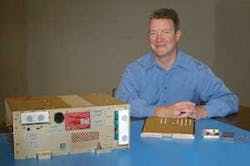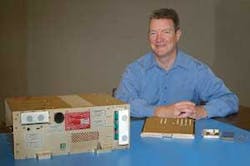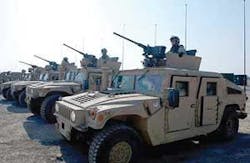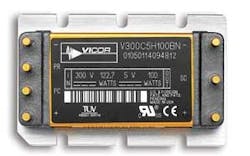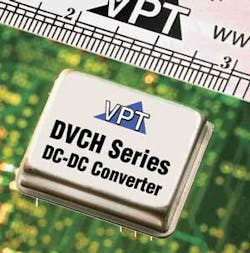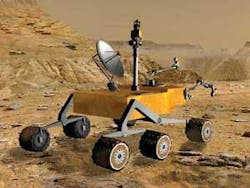Power electronics drive next-generation vehicles
Engineers are building power integrated circuits and other power components to match growing current needs and the efficiencies of unmanned aerial vehicles, manned aircraft, spacecraft, and ocean-going ships, as well as armored combat vehicles.
By Ben Ames
From electric-drive ships to hybrid Humvees, military vehicles that rely on electric motors rather than internal-combustion engines will soon rely on advanced power electronics to handle huge voltages in their drive trains.
Power components also must stretch to handle extra-low voltages, as computer designers demand power below 5 volts for the latest microprocessors. Designers are also using new kinds of power components for tasks like replacing hydraulic flight controls with electric motors on commercial aircraft.
At the same time, designers are seeking to reduce the size and weight of the components they use in unmanned aerial vehicles and unmanned ground vehicles. They are also trying to shave ounces from the increasing array of electronic gear that U.S. troops will carry onto the future networked battlefield.
The next great frontier
Power electronics always have driven the systems and sensors aboard military vehicles. In the next generation of military designs, power electronics will grow to handle the drive train of the entire vehicle. Designers of military vehicles, in fact, see electric power as the next great frontier.
Electric power is already the solution for industrial applications that need tremendous torque, such as freight-train locomotives and the huge dump trucks that operate in strip mines.
That is the same approach that Boeing engineers plan to use in the “hybrid electric drive architecture” for manned and unmanned vehicles in the Future Combat System family of battlefield vehicles, due to be phased into use over the next 10 years.
Now naval architects are designing an all-electric version of the Nimitz-class aircraft carrier. Electricity would drive everything from the propellers, to aircraft-launching catapults, to deck guns. Other designers are looking to electricity for unmanned aerial vehicles (UAVs) and for ground vehicles powered by hybrid gas-electric engines or fuel cells.
The trend also applies to civilian aircraft. Engineers at Boeing Commercial Airplanes in Renton, Wash., plan to eliminate compressed air and hydraulic-controlled actuators for the flight controls in next-generation planes like the 787 Dreamliner, says Rick Furtney, vice president of the high-reliability business unit for International Rectifier in El Segundo, Calif.
Regardless of the platform, all-electric systems generally call for two types of motors-variable-speed motors for fuel pumps and vehicle drives, or precision-control actuators for gun turrets and flight controls. All those electric motors put a tremendous load on a vehicle’s electric system.
The future all-electric aircraft carrier will use electricity for more than just its propellers; it will also launch airplanes and fire guns with electricity. “It will have a huge power plant essentially to run thousands of volts through the entire carrier,” Furtney says.
So technicians at International Rectifier build 600- and 1,200-volt insulated- gate bipolar transistors (IGBTs) for such applications. IGBTs are voltage-controlled power transistors that have higher current densities than equivalent high-voltage- power metal-oxide-semiconductor field-effect transistors (MOSFETs). The company also makes a hermetically sealed variety of IGBT for military flight control.
Hybrid drives
Military designers are also driving the move to electric power as a way to achieve better fuel efficiency.
Oil prices have been rising quickly for domestic consumption, and they are even higher on the battlefield. By the time it reaches the front lines, gasoline can cost $40 to $600 per gallon including security and transportation, he says. Hybrid and electric vehicles represent one way to cut those costs.
Electric motors also make less noise than internal-combustion engines. Army leaders are designing a gas-electric hybrid Humvee that can travel nearly 470 miles on a 25-gallon tank-or about 19 miles per gallon-and then drive another 25 miles in silence using battery power alone. Humvee is the military’s nickname for the High-Mobility Multipurpose Wheeled Vehicle, or HMMWV.
Another benefit of electric vehicles is their ability to share power more easily than gasoline-powered trucks can.
“We learned in Iraq we needed generators on the battle frontier, so now we need to make more-robust generators and add them to vehicles,” Furtney says. “All the Humvees can’t be pulling generator trailers around, so instead we’re trying to integrate the generator into the vehicle.”
Power electronics drive avionics
The next generation of aircraft will rely more on electric drives and actuation than ever before, which represents a complex challenge for power distribution, whether it is driving a low-power task like a cathode-ray tube or image intensifier, or a high-power device like a radar, traveling wave tube (TWT), or electronic countermeasures.
In civil aerospace applications, the Boeing 787 Dreamliner and Airbus A380 passenger jets use variable-frequency power, with increased demand for electric motors and motor controllers as opposed to hydraulic actuation, says Mark Stefanich, business development manager for Aircraft Electrical Power at Crane Aerospace & Electronics in Lynnwood, Wash.
In fact, the 787 needs a total generator capacity of one megawatt-twice what was necessary for predecessors like the 737 and 777, he says.
At the same time, designers are applying lower voltage at the point of load-such as the card or system distribution level-while retaining standard power at the main distribution bus. That means they need to use an intermediate bus architecture to step the main load down far enough to use commercial off-the-shelf (COTS) products. A typical main bus supplies 28 volts, while an intermediate bus drops that to 12 or 5 volts.
Customers are also demanding better use of generators, he says. Electric aircraft controls need more stringent power quality, and that means increasing the number of solid-state components to create high power and low distortion for applications such as head-up displays, radar, and electronic countermeasures.
To meet those demands, Crane engineers use solid-state switching and new topologies like three-phase harmonic correction, says Ernie Parker, director of technology development for Crane’s Power Solutions group.
They also design customized power electronics that enable military architectures to work with COTS parts, since military designers have adopted the trend of using low-voltage processors from the telecommunications server world.
The increased demand for custom power solutions also comes from original equipment manufacturers (OEMs) pushing integration work to their customers, who then outsource it to companies like Crane.
Customers have also been requesting help in providing certification for DO 254, the military hardware quality-assurance requirement.
“We are having to create our own standard products that mimic industry solutions, such as point-of-load regulators, bus converter modules, and off-the-shelf VME solutions,” Parker says. Military applications have unique demands for input voltage, environmental protection, and process-control (such as verifying design process to agree with DO 254).
“Our customers want to take advantage of COTS reliability and cost, but as they move up in complexity, they must make adaptations,” he says. For example, Crane makes a VME card-slot power supply with standard DC-DC converters but with custom interface circuits. The unit can deal with wide-ranging military transient standards as opposed to the more restricted power-input range required by COTS parts.
“It mimics what’s on the commercial market, because the needs are the same, but in a version that maps better to military input ranges and provides process data for DO 254. We provide COTS standards with a military pedigree,” says Parker.
Fighter jets need power efficiency
Size and weight are crucial details for military avionics and satellite designers. They look for high power density in a small package, with hermetic seals and broad temperature ranges.
Temperature is a crucial measure because airplane components can get hot sitting on a runway in Saudi Arabia, then quickly become freezing cold in high altitude during flight, says Mike Bosmann, senior vice president of sales and marketing at VPT in Blacksburg, Va.
Efficiency is also critical for designers of military aircraft, instruments, and satellites. That is the goal for VPT’s new DVCH product line of DC-DC converters, designed to deliver very low power output-1.5 watts and below-over a wide voltage range with hermetic sealing and a broad temperature range.
The unit accepts military input voltages from 12 to 50 volts input voltage, and offers single-voltage outputs of 3.3, 5, 5.2, 12, and 15 volts. Until now, designers could use VPT’s 5-watt product for those applications, but they paid a price in efficiency, he says.
“Usually noise and efficiency are sacrificed for small size, wide input voltage range, and full military operating range,” says Bosmann. “Our technology enables us to deliver a converter that provides a higher power-conversion efficiency and carries an output ripple that is one-sixth the noise of our closest competitor.”
Customers are also asking for lower voltage parts. So last year, VPT released two product families of triple-output units; one rated at 5 volts and one rated at 3.3 volts.
And in 2003, VPT designers developed the DVSB brand of DC-DC power converter for the F-35 Joint Strike Fighter. It uses dual pulse width modulation (PWM) chips to generate split outputs at 3.3 and 5 volts from an input range of 15 to 50 volts. This product allowed engineers to use a single component instead of two, saving valuable weight and volume on the aircraft.
Satellites use lower voltage
Manufacturers of electrical components for space applications face the opposite challenge-whereas voltages are rising on vehicle motors, they are dropping on satellites.
A typical satellite bus runs at 100, 50, or 28 volts, depending on the manufacturer and whether it’s used for commercial communications or military imaging and targeting, says International Rectifier’s Furtney.
Designers then break that current down to 50 volts and down again to 5 volts to route it through the system. Modern microprocessors on small die sizes use even less voltage, so designers must step the power down yet again, reaching 3.3, 2.5, or even 1.8 volts.
That is crucial in space because satellite designers are handling more and more of the processing load on the spacecraft itself, instead of shipping bulky raw data back to Earth on limited bandwidth.
“Now we’re going to point of load regulation, because a single satellite can be running several different voltages,” Furtney says. “If you’re running an FPGA at 1.8 volts and a processor at 2.5, the I/O can be at 3.3 and the memory core is usually even lower. Advanced architecture often needs more diverse voltages, to handle the increased processing in a space environment.”
Space platforms are also using more solid-state power components.
Designers of space-based platforms have always used mechanical relays for radiation-hardened applications. Yet those relays often fail because of shock and vibration, hardening of contact lubricant in space temperatures, and the increased weight of extra parts to handle low-voltage logic gates.
So designers at International Rectifier have launched rad-hard, solid-state relays. The RDHA7x series offers switching speeds comparable to mechanical units, but has better performance in shielding electromagnetic and radio-frequency interference, says Alan Tasker, engineering lead for space module products at International Rectifier HiRel Products LLC in Leominster, Mass.
A typical unit has three main components: an input buffer, an optoisolator, and a rad-hard MOSFET. Compared to other solid-state relays on the market, it boasts lower system electrical noise and a direct interface to logic, Tasker says.
Customers ask for rad-hard parts to guard against many scenarios-the slow-and-steady Total Indicated Dose for a long-endurance satellite, the Single Event Effect of heavy ions hitting a booster rocket, or battlefield radiation exposure.
Power components land on Mars
Engineers who design satellites and spacecraft have special demands for electronic parts. They must be radiation-hardened to withstand exposure to radiation as strong as 100 kilorads for long-endurance missions. They also must be efficient because electric power is scarce in space, generated sporadically by solar panels and stored in batteries.
Engineers at Aeroflex in Plainview, N.Y., held those demands in mind as they designed a radiation-hardened, pulse width modulation chip called the ACT5031 to meet specifications for the mobile Mars Science Laboratory rover, a NASA project scheduled for launch in 2009. That rover will carry sensors from the Russian and Spanish space agencies to find potential habitats for past or present life, and will plan to remain active for one Mars year (equal to two Earth years) after landing.
Aeroflex engineers worked alongside designers from the NASA Jet Propulsion Laboratory in Pasadena, Calif., and the Applied Physics Lab at Johns Hopkins University in Baltimore. The result is a chip that has low standby power, can operate efficiently in sleep mode, and complements existing radiation-hardened DC-to-DC converters, says Joe Castaldo, director of sales and marketing for the Aeroflex microelectronics operation.
Company engineers made the chip efficient by building it with a CMOS process, as opposed to bipolar or non-CMOS. They also enabled the device to tolerate as much radiation as 100 kilorads by building it with a 0.6-micron commercial rad-hard process.
When they release the ACT5031 in July, Aeroflex will position it against competing products from Texas Instruments in Dallas, Linear Technology in Milpitas, Calif., and SGS-Thomson, now known as STMicroelectronics, in Carrollton, Texas.
Customers want to buy electronic components off the shelf, which is why Aeroflex has expanded its family of rad-hard voltage regulators for satellite applications. The company started with the ACT8601 in 1999, built to withstand a total dose of radiation as strong as 100 kilorads. The device offers adjustable output voltage from 1.2 to 37 volts, 1.5-amp output current, hermetic packaging, and a temperature range for industrial, military, and space demands.
The company offers four related choices: the 8603 and 04 offer 30-kilorad protection for three-to-six-month missions, while the 8601 and 02 offer full 100-kilorad protection for 10-year endurance.
Customers also demand standard military drawings (SMDs) crafted to standards set by the U.S. Army’s Defense Supply Center Columbus (DSCC) in Columbus, Ohio, and the resulting data sheet. Aeroflex has submitted these components for approval.
Components shrink to fit on UAVs
When military designers need a power converter, they usually choose a DC-DC converter brick. Most COTS applications can use a full-, half-, or quarter-brick, while specialized jobs use one-eighth or one-sixteenth. Now they have another option-the VI Chip from Vicor Corp. in Andover, Mass. The chip can replicate the functionality of a full brick in one-fifth the space, while offering better performance in efficiency, noise, transient response, and cost, says Andrew Hilbert, senior director of product marketing for Vicor.
With its small size and weight, the VI Chip would be a good match for unmanned aerial vehicles (UAVs) and for personal electronics carried by soldiers.
Some engineers combine bricks and chips. They face a challenge of stepping voltage down low enough to power the latest processors, so they often use a brick upstream and then a VI Chip to drop power from 5 volts to 3.3 or lower, Hilbert says.
Vicor is also working on a version of the chip that will handle higher voltages, necessary for electric-drive vehicles. The current product family serves the 48-volt commercial market, but Vicor engineers plan to release an extension for 300-volt jobs, as well as a family built for the 28-volt COTS market, with an extension for 270-volt high-power jobs.
Military specifications often require unique input voltages and EMI standards, so Vicor engineers can build almost any custom solution, says Keith Nardone, senior military product marketing manager. That is crucial to serve a military market challenged by parts that become obsolete within a year or two, he says. So Vicor designers use the company’s library of DC-DC converters as a menu of standard building blocks, then optimize the part for main circuits, ancillary circuits, thermals, and packaging.
Company Information
Absopulse Electronics Carp, Ontario 613-836-3511 www.absopulse.com
Advanced Linear Devices Inc. Sunnyvale, Calif. 408-747-1155 www.aldinc.com
Advanced Power Technology Bend, Ore. 541-382-8028 www.advancedpower.com
Aeroflex Plainview, N.Y. 516-694-6700 http://ams.aeroflex.com
Behlman Hauppauge, N.Y. 631-435-0410 www.behlmanpower.com
Crane Interpoint Redmond, Wash. 425-882-3100 www.interpoint.com
Diversified Technology Inc. Ridgeland, Miss 800-443-2667 www.dtims.com
Fairchild Semiconductor South Portland, Maine 207-775-8100 www.fairchildsemi.com
Gaia Converter Inc. Saint Laurent, Quebec 888-601-3169 www.gaia-converter.ca
International Rectifier El Segundo, Calif. 310-726-8000 www.irf.com
Intersil Corp. Milpitas, Calif. 408-432-8888 www.intersil.com
K&M Electronics West Springfield, Mass. 413-263-6200 www.kandm.com
Kepco Inc. Flushing, N.Y. 718-461-7000 www.kepcopower.com
Martek Power Los Angeles, Calif. 310-202-8820 www.martekpowerabbott.com
MS Kennedy Corp. Liverpool, N.Y. 315-701-6751 www.mskennedy.com
Micro Power Hillsboro, Ore. 503-693-7600 www.micro-power.com
North Atlantic Industries Bohemia, N.Y. 631-567-1100 www.naii.com
Pico Electronics Inc. Pelham, N.Y. 914-738-1400 www.picoelectronics.com
Pioneer Magnetics Santa Monica, Calif. 310-829-6751 www.pioneermag.com
Pivotal Power 902-832-7359 www.pivotalpower.com
Powerex Youngwood, Pa. 724-925-7272 www.pwrx.com
Rantec Power Systems Los Osco, Calif. 805-596-6000 www.rantec.com
Richardson Electronics LaFox, Ill. 630-208-2200 www.rell.com
RO Associates Inc. Sunnyvale, Calif. 408-744-1450 www.roassoc.com
Semicoa Semiconductors Costa Mesa, Calif. 714-979-1900 www.semicoa.com
Solid State Devices Inc. La Mirada, Calif. 562-404-4474 www.ssdi-power.com
Solitron Devices Inc. West Palm Beach, Fla. 561-848-4311 www.solitrondevices.com
Spectrum Control Fairview, Pa. 814-474-2207 www.spectrumcontrol.com
Transistor Devices Inc. (TDI) Franklin, Mass. 508-520-9960 http://tdipower.com
Teledyne Technologies Los Angeles, Calif. 310-893-1600 www.teledyne.com
Tracewell Systems Westerville, Ohio 614-846-6175 www.tracewellsystems.com
Transistor Devices Hackettstown, N.J. 908-850-5088 www.tdipower.com
Vicor Corp. Andover, Mass. 978-470-2900 www.vicorpower.com
Vishay Siliconix Malvern, Pa. 402-563-6866 www.vishay.com
VPT Inc. Everett, Wash. 425-353-3010 www.vpt-inc.com
